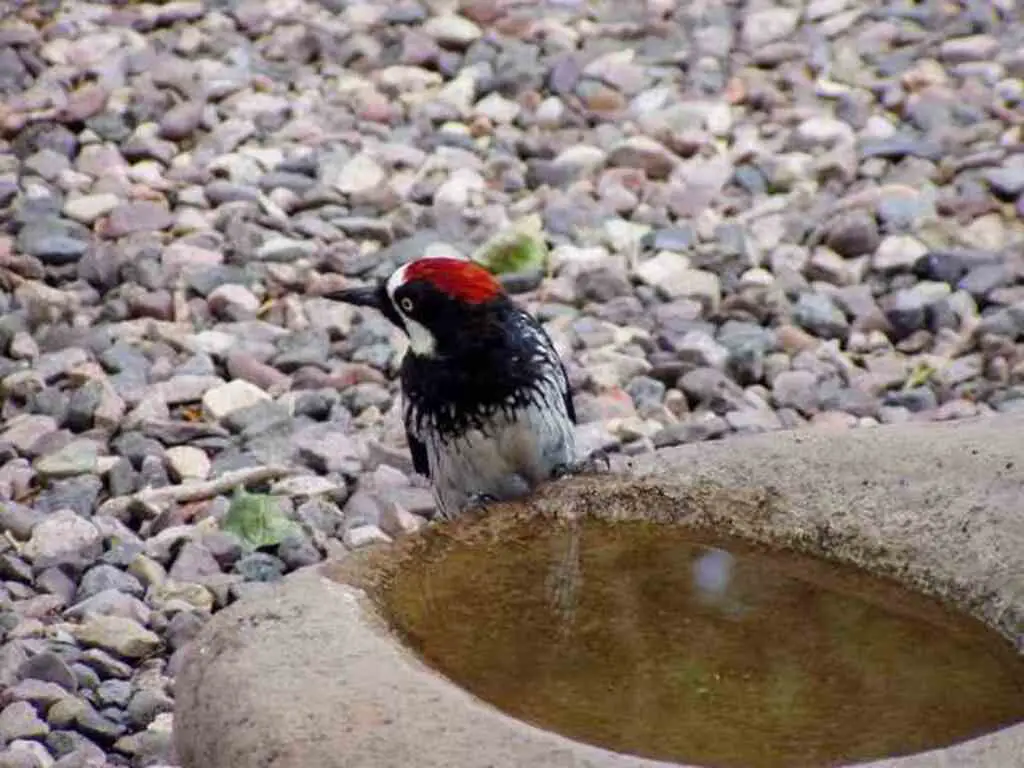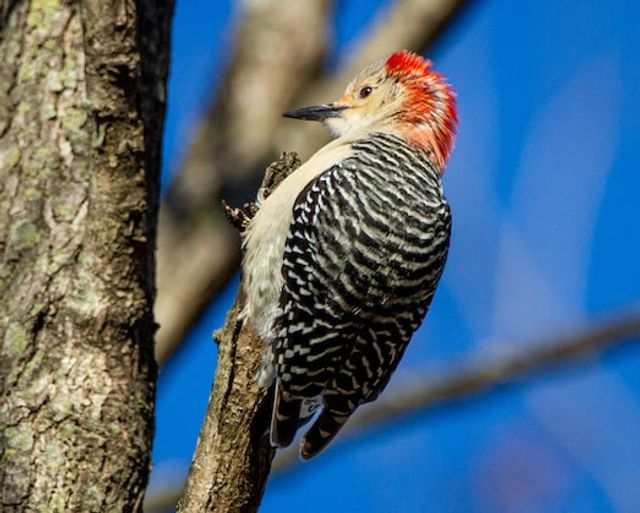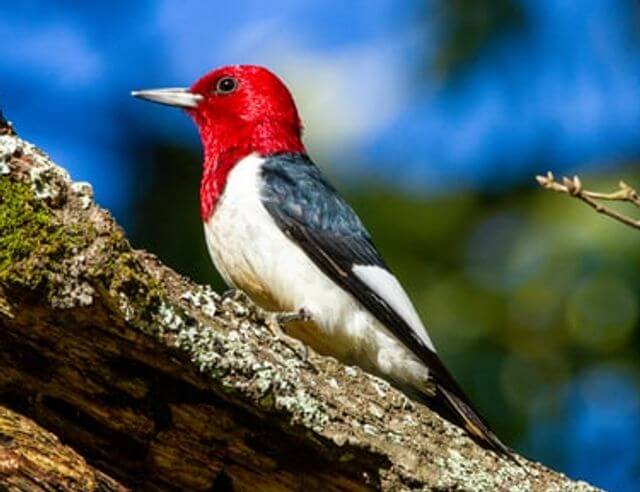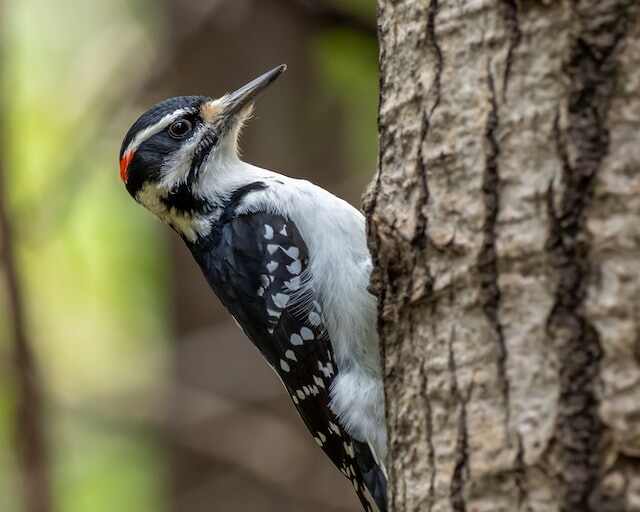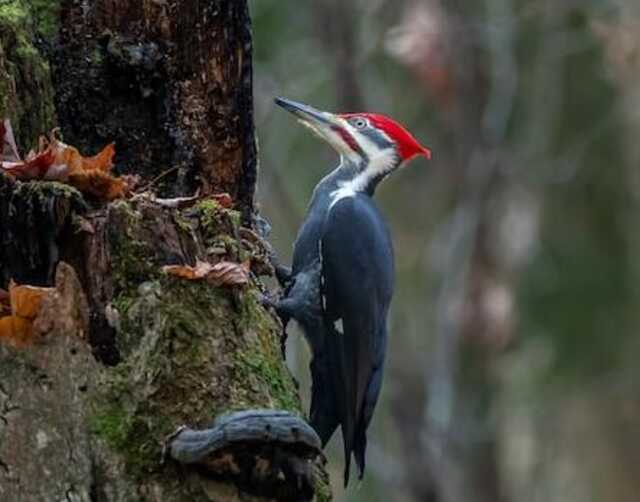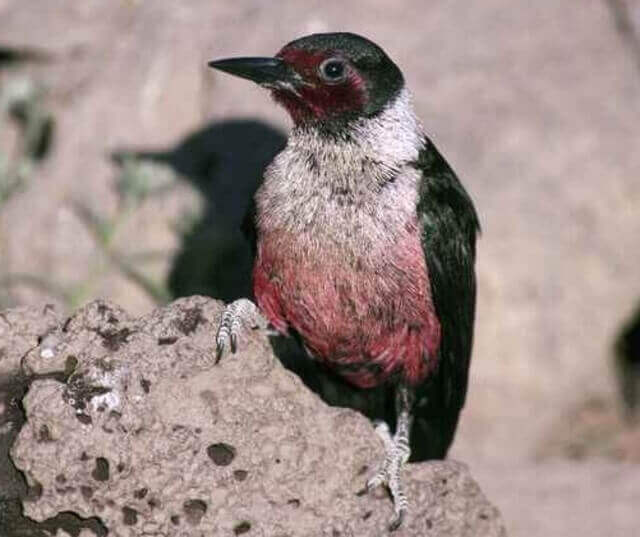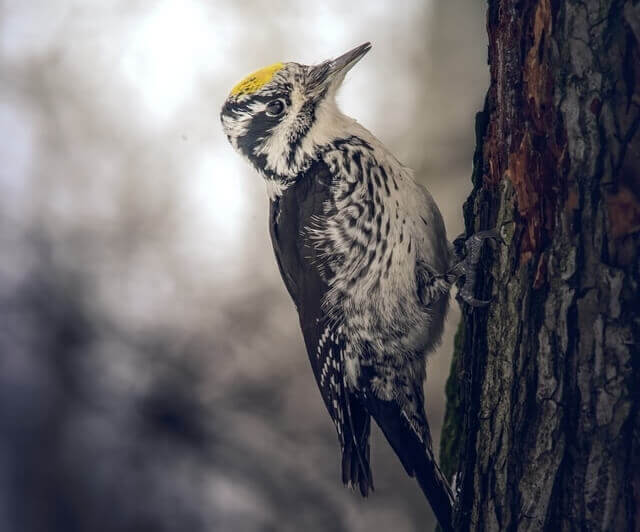Embark on a journey through Nebraska’s woodlands with our ultimate guide featuring 8 remarkable woodpecker species! From the vibrant Red-headed Woodpecker to the elusive Red-bellied Woodpecker, Nebraska’s diverse ecosystems offer a haven for these captivating birds.
In this comprehensive guide, we’ll uncover the unique characteristics, habitats, and behaviors of each woodpecker species, providing valuable insights for bird enthusiasts and nature lovers.
Table of Contents
Types of Woodpeckers in Nebraska
Downy Woodpecker
- Length: 5.5-6.7 in (14-17 cm)
- Weight: 0.7-1.0 oz. (21-28 g)
- Wingspan: 9.8-11.8 in (25-30 cm)
- Scientific Name: Picoides pubescens
- Frequency of Occurrence: 25.79% (Statistic by: eBird)
- Maps: Range Map – Sightings Map
- Sounds: Calls and songs
- Where To Find Them: It is a common bird found in many locations throughout Nebraska. It can be found in open areas such as fields and brushlands, as well as in forests and other wooded areas.
- How to Attract: Downy woodpeckers are attracted to feeders that offer a variety of foods, including suet, mealworms, and cracked corn. Suet feeders are the best option for these birds because they provide plenty of high-fat food. Hopper feeders are also popular with downy woodpeckers, as they allow them to pick out their own food. Platform feeders are a good choice for large groups of birds, as they allow them to easily access several different foods at once.
Description: The Downy Woodpecker is a common woodland bird found throughout most of North America. It ranges from the far north down to southern Mexico and Central America, and also inhabits parts of South America. The Downy Woodpecker is a small bird, with a length of about 17 cm (6 inches). It has a stocky build, short wings and a broad tail.
The Downy Woodpecker is a colonial woodpecker. It builds its nest in the cavity of an old tree, typically 3-5 meters (10-16 feet) up in the trees. The female lays 4-8 white eggs, which are incubated for about 12 days by the father alone. When the chicks hatch, they are fed by their parents for about another 21 days until they fledge and can fly on their own.
Related: How to Attract Downy Woodpeckers to Your Yard? (Easy!)
Red-bellied Woodpecker
- Length: 9.5 in (24 cm)
- Weight: 2.0-3.2 oz. (56-90 g)
- Wingspan: 13.0-16.5 in (33-42 cm)
- Scientific Name: Melanerpes carolinus
- Frequency of Occurrence: 18.95%
- Maps: Range Map – Sightings Map
- Sounds: Calls and songs
- Where To Find Them: Some of their key spots in Nebraska include the Otoe National Forest, the Niobrara National Wildlife Refuge, and Preserve Lake State Park.
- How to Attract: To attract this bird to your yard, you can provide suet feeders with suet or you can also offer seeds such as sunflower seed on a platform feeder.
Description: The Red-bellied Woodpecker is a common woodpecker in the eastern and central United States. They are most commonly found in forests, but can also be found around human habitation. This woodpecker ranges from Nova Scotia to Texas, and has a North American population of about 15 million. The Red-bellied Woodpecker is found in a variety of habitats, including suburban and urban areas, agricultural land, and forest.
This woodpecker is typically found in trees or on the ground near them. The diet is varied and includes insects, small birds, and even small mammals. They often select trees that have a lot of insects on them, as these are the easiest food sources to find. Other times they will search for prey by climbing high in trees to spot animals on the ground. They are also known to feed on fruit, sap, and other plant material.
Related: How to Attract Red-bellied Woodpeckers to your Yard?
Red-headed Woodpecker
- Length: 7.5-9.1 in (19-23 cm)
- Weight: 2.0-3.2 oz. (56-91 g)
- Wingspan: 16.5 in (42 cm)
- Scientific Name: Melanerpes erythrocephalus
- Frequency of Occurrence: 9.62%
- Maps: Range Map – Sightings Map
- Sounds: Calls and songs
- Where To Find Them: The red-headed woodpecker is a common bird in Nebraska. They are found in many areas of the state, but some of their favorite spots include the Platte River Valley, the Niobrara Valley Preserve, and eastern Iowa.
- How to Attract: One way is to offer them a suet feeder filled with fresh, peanut butter suet-based food. Alternatively, you could use a platform feeder that dispenses seed or mealworms. Both of these types of feeders will provide the woodpecker with plenty of sustenance.
Description: The red-headed woodpecker is a common bird found across much of North America. In the East, it ranges from southern New England and Rhode Island south to Florida and west to eastern Texas and Oklahoma. In the West, it ranges from British Columbia south to northern Mexico. This species prefers to live in areas with dense tree coverage. The red-headed woodpecker is mainly a forest bird, but can also be found living in suburban areas and even on some farms.
This woodpecker is known for its loud call, which it uses to attract mates or warn others of danger. The diet of the Red-headed Woodpecker is varied and includes insects such as ants, termites, beetles, and crickets. They may also eat small birds eggs, nesting birds, small mammals, and reptiles.
Related: Interesting Red-Headed Woodpecker Facts (Explained)
Hairy Woodpecker
- Length: 7.1-10.2 in (18-26 cm)
- Weight: 1.4-3.4 oz. (40-95 g)
- Wingspan: 13.0-16.1 in (33-41 cm)
- Scientific Name: Picoides villosus
- Frequency of Occurrence: 7.52%
- Maps: Range Map – Sightings Map
- Sounds: Calls and songs
- Where To Find Them: Hairy Woodpeckers are found in areas such as the Platte River Valley, the Niobrara River Valley, and parts of eastern Nebraska. However, they are most commonly found near large bodies of water such as rivers, lakes, and reservoirs.
- How To Attract: Hairy Woodpeckers are attracted to suet feeders with peanut butter suet or sunflower seed platforms. These feeders can be easy to set up and provide a constant stream of food for the birds. Mealworms can also be a great addition to these feeds, as they offer a high-quality, protein-rich diet.
Description: Hairy Woodpeckers are found in the eastern United States, from New Jersey to Florida and west to Texas. They are common in Canada, and parts of Central America, and South America. This woodpecker is a common bird in its area, but it can be difficult to find because it prefers mature trees with plenty of dead wood. They live in many habitats including coniferous, mixed wood, deciduous and urban areas.
This woodpecker consumes a mostly insect-based diet. The woodpeckers’ beak is specially adapted to extracting insects from tree bark, and their tongues are covered in bristles that help them pry into tight crevices. They typically eat insects such as ants, termites, beetles, moths and caterpillars, but they will also eat fruits and nuts.
Pileated Woodpecker
- Length: 15.8-19.3 in (40-49 cm)
- Weight: 8.8-12.3 oz. (250-350 g)
- Wingspan: 26.0-29.5 in (66-75 cm)
- Scientific Name: Dryocopus pileatus
- Frequency of Occurrence: 0.5259%
- Maps: Range Map – Sightings Map
- Sounds: Calls and songs
- Where To Find Them: Although very rare in Nebraska. There are two main areas where you can find Pileated Woodpeckers, the Sandhills and the High Plains. The Sandhills are a region of grasslands and prairies that stretches from southern Missouri all the way to eastern Texas. The High Plains is a much wider area that covers parts of western Kansas, Oklahoma, Colorado, New Mexico, Utah, and Wyoming.
- How To Attract: To attract this bird to your yard, you can either use suet feeders with suet, or platform feeders with black-oil sunflower seed. Both of these feeders work well and have different benefits. Mealworms can also be added to a platform feeder as an additional attractant.
Description: The distribution range of the pileated woodpecker ranges from the Southern Appalachian Mountains to the Atlantic and Gulf Coasts. In the Appalachian Mountains, they are found in Georgia, Tennessee, North Carolina, and Virginia. They also occur in Arkansas, Louisiana, Oklahoma, and Texas. In the Great Lakes region they are found in Michigan, Ohio, Pennsylvania, and New York.
Outside these areas, they are rare or absent. Their preferred habitats include mixed hardwood and conifer forests, but they will also use oak-hickory forest and other deciduous woods. They specialize in eating carpenter ants, wood boring beetle larvae, termites, flies, caterpillars, and cockroaches. The birds eat these insects by pecking them out of the ground or out of tree trunks.
Related: How to Attract Pileated Woodpeckers to your Yard (Fast)
Lewis’s Woodpecker
- Length: 10.2-11.0 in (26-28 cm)
- Weight: 3.1-4.9 oz. (88-138 g)
- Wingspan: 19.3-20.5 in (49-52 cm)
- Scientific Name: Melanerpes lewis
- Frequency of Occurrence: 0.0616%
- Maps: Range Map – Sightings Map
- Sounds: Calls and songs
- Where To Find Them: The Lewis’s Woodpecker is a very rare bird in Nebraska. It is found in areas with tall trees and dense understory, such as the Sandhills and the Niobrara Valley.
- How to Attract: If you’re looking to attract the Lewis’s Woodpecker, using suet feeders with suet or platform feeders with black-oil sunflower seed is a good way to go. Both work well. Mealworms can also be added to a platform feeder as an additional food source.
Description: The distribution range of Lewis’s Woodpecker is limited to the east-central United States and southeastern Canada. In the east-central US, they are found in Arkansas, Louisiana, Mississippi, Oklahoma, Texas and part of north-central Florida; in Canada, they are found in most of Ontario and eastern Quebec. They also occur sporadically in other parts of North America. Lewis’s Woodpecker is found in a variety of habitats, including deciduous and coniferous forests, suburban gardens, and orchards.
This woodpecker is a cavity nester, which means it excavates holes in trees to build its nest. This bird is best known for its characteristic beak, which it uses to extract food items from wood. The Lewis’s Woodpecker primarily consumes insects, but will also consume other small animals. Carpenter ants and woodboring beetle larvae are two of the most common items on the Woodpecker’s diet. Termites and flies have also been noted as occasional food choices.
American Three-toed Woodpecker
- Length: 8.3-9.1 in (21-23 cm)
- Weight: 1.6-2.4 oz. (44.8-67.9 g)
- Wingspan: 14.6-15.3 in (37-39 cm)
- Scientific Name: Picoides dorsalis
- Frequency of Occurrence: 0.0019%
- Maps: Range Map – Sightings Map
- Sounds: Calls and songs
- Where To Find Them: The American Three-toed Woodpecker is a very rare bird in Nebraska. They are typically found in areas with lots of trees, such as the Great Plains.
- How to Attract: Attracting the American Three-toed Woodpecker to your backyard can be as simple as providing them with a suet feeder with suet, or a platform feeder with black-oil sunflower seed. These birds are attracted to food that is high in fat and protein. Additionally, scattering some mealworms on the feeder will also work well to attract this bird.
Description: The American Three-toed Woodpecker is a small bird that can be found across much of northern North America. In its distribution range, the Three-toed Woodpecker can be found in mountain ranges from southern Alberta to New Hampshire and west to Montana and Wyoming. This woodpecker prefers coniferous forest, both the boreal forest and temperate deciduous forest.
They also live in dry open woodlands, gardens, and orchards. The American Three-toed Woodpecker is a small bird that feeds primarily on wood-boring beetle larvae, also eating moth caterpillars, various insects, and fruit. The bird pecks at the insects or larvae with its beak, then slurps them up from the surface of the tree.
Acorn Woodpecker
- Length: 7.3-9.4″ in (18.5-24.0 cm)
- Weight: 2.3-3.2 oz. (65-90 g)
- Wingspan: 13.8-17.7 in (35-45 cm)
- Scientific Name: Melanerpes formicivorus
- Frequency of Occurrence: 0.0001%
- Maps: Range Map – Sightings Map
- Sounds: Calls and songs
- Where To Find Them: The Acorn Woodpecker is a very rare bird in Nebraska, and they are only found in a few areas. They are most common in the Sand Hills region of Nebraska, but they have been spotted as far north as Scottsbluff.
- How To Attract: If you’re searching for a bird to add to your backyard ecosystem, the Acorn Woodpecker may be a good option. These birds are attracted to feeders that have suet or black-oil sunflower seed as the primary food source. Additionally, providing mealworms on a platform feeder can be a great way to attract these birds.
Description: The Acorn Woodpecker is a common bird in much of its range, but it is especially widespread in the eastern United States. In the Northeast it ranges from Maine to Georgia, and south to North Carolina and Tennessee. Outside of the East, this woodpecker is found mainly in the West, from California northward through Oregon, Washington, and British Columbia. In total, the Acorn Woodpecker ranges across 14 states.
This bird prefers to live in oak and other hardwood forests, but it will also inhabit pine plantations and other secondary growth habitats. The Acorn Woodpecker is an interesting bird because its diet consists almost entirely of manly acorns! Insects are also a part of the Acorn Woodpecker’s diet, but they tend to be in smaller numbers than acorns. Seeds make up a small percentage of the bird’s diet, and fruit is not very common.
Related Post: 66 Common Birds in Nebraska 2022 (Ultimate Field Guide!)

